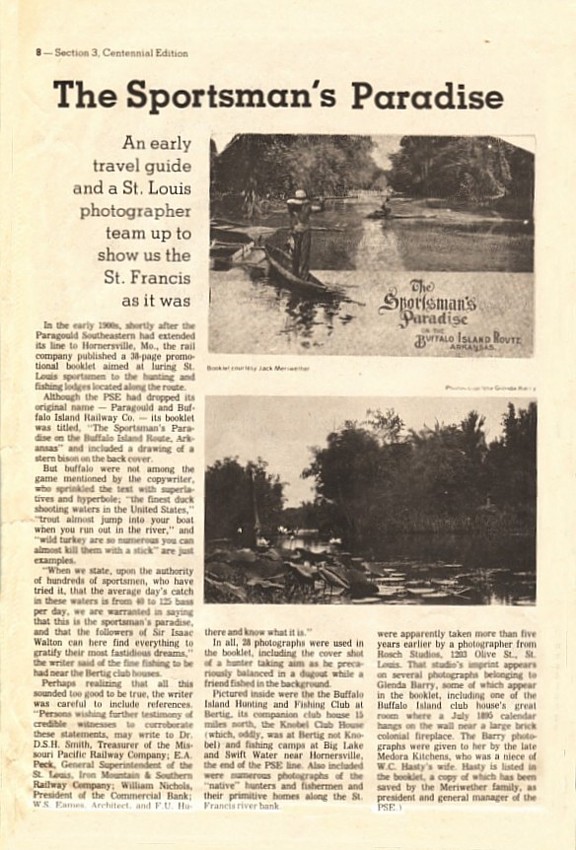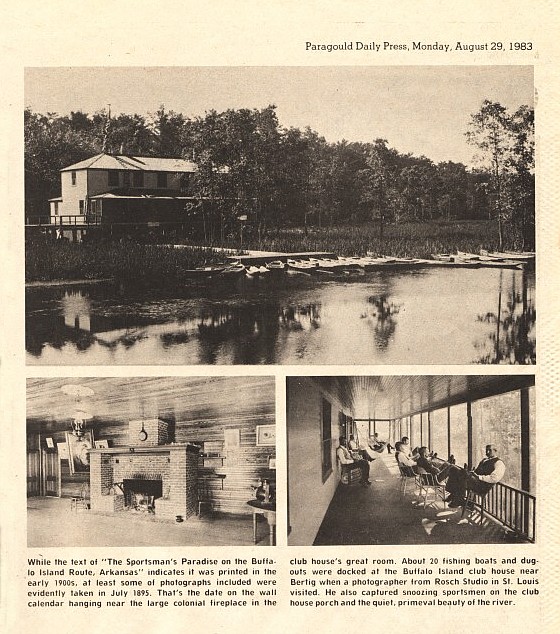|
The Sportsman's Paradise |
 |
 Booklet courtesy Jack Meriwether Photo courtesy Glenda Barry
|
| In the early 1900s, shortly after
the Paragould Southeastern had extended its line to Hornersville,
Mo., the rail company published a 38-page promotional booklet aimed
at luring St. Louis sportsmen to the hunting and fishing lodges
located along the route. Although the PSE had dropped its original
name -- Paragould and Buffalo Island Railway Co. - its booklet was titled, "The
Sportsman's Paradise on the Buffalo Island Route, Arkansas" and
included a drawing of a stern bison on the back cover. But
buffalo were not among the game mentioned by the copywriter, who
sprinkled the text with superlatives and hyperbole; "the finest duck
shooting waters in the United States," "trout almost jump into your
boat when you run out in the river," and "wild turkey are so
numerous you can almost kill them with a stick" are just examples. "When we state, upon the authority of hundreds of sportsmen, who have tried it, that the average day's catch in these waters is from 40 to 125 bass per day, we are warranted in saying that this is the sportsman's paradise, and that the followers of Sir Isaac Walton can here find everything to gratify their most fastidious dreams," the writer said of the fine fishing to be had near the Bertig club houses. Perhaps realizing that all this sounded too good to be true, the writer was careful to include references. "Persons wishing further testimony of credible witnesses to corroborate these statements, may write to Dr. D. S. H. Smith, Treasurer of the Missouri Pacific Railway Company; E. A. Peck, General Superintendent of the St. Louis, Iron Mountain & Southern Railway Company; William Nichols, President of the Commercial Bank; W. S. Eames, Architect, and F. U. Hugunin, all of St. Louis, who have been there and know what it is." In all, 28 photographs were used in the booklet, including the cover shot of a hunter taking aim as he precariously balanced in a dugout while a friend fished in the background. Pictured inside were the the Buffalo Island Hunting and Fishing Club at Bertig, its companion club house 15 miles north, the Knobel Club House (which, oddly, was at Bertig not Knobel) and fishing camps at Big Lake and Swift Water near Hornersville, the end of the PSE line. Also included were numerous photographs of the "native" hunters and fishermen and their primitive homes along the St. Francis river bank. (At least some of the photographs were apparently taken more than five years earlier by a photographer from Rosch Studios, 1203 Olive St., St. Louis. That studio's imprint appears on several photographs belonging to Glenda Barry, some of which appear in the booklet, including one of the Buffalo Island club house's great room where a July 1895 calendar hangs on the wall near a large brick colonial fireplace. The Barry photographs were given to her by the late Medora Kitchens, who was a niece of W. C. Hasty's wife. Hasty is listed in the booklet, a copy of which has been saved by the Meriwether family, as president and general manager of the PSE.) While the booklet sang the praises of the St. Francis, Big Lake and other nearby sporting sites, it also listed the commercial merits and potential of Paragould, Bard, Bertig, Cardwell, Klondike and Hornersville. Mention of Paragould's "elegant churches, handsome residences, good schools" and of "the fines timber and agricultural lands of Southeast Missouri and Northeast Arkansas" suggest the booklet was also aimed at "home seekers and investors." This commercial angle allowed the booklet, as well as the sportsmen, to mix business with pleasure. "After the extension of the Paragould Southeastern Railroad," the writer noted, "hundreds of investors have visited Hornersville and very few have gone away without buying a town lot a fine farm or opening up some kind of business." Of the Bard-Bertig area, the writer pointed out that the Meiser Lumbering Company owned "thousands of acres of good tillable land, which they offer to home seekers and investors at low prices." "But," the writer continued, getting back to the main business of the booklet, "to prospectors, and especially the devotees of the rod and gun, the leading attractions at Bertig are the splendid club houses. These club houses are built partly extending into the river, and you step from their broad verandas into your boat and go in any direction you may choose in quest of game and fish." This club house was located about one-half mile from Seneca Slough ("which affords the best duck shooting from the first of September until the first of March") and a mile and a half by hand car from Badwell's Lake ("celebrated for its fine fly and minnow fishing"). The club charged $1 per day for members and $2 for non-members. Memberships cost $2.50 a year and both officers were St. Louis businessmen. But as the writer noted, "The Buffalo Island Hunting and Fishing Club, with S. Virgilio as manager, is a home for the weary traveler from whatever direction he may come." |